Glock 45 Aimpoint COA Pros & Cons
Pros
- Bombproof reputation
- Excellent viewing window
- Brightness for all scenarios
Cons
- Must purchase with Glock
The Bottom Line
The Glock 45 + Aimpoint COA is another legendary gun and optics combo, but this is a package deal that may be too pricey for some.
Each year, SHOT Show serves as a launch for all kinds of great new products. This year was no exception, and it featured a new collaboration between Glock and Aimpoint.
Following the trend of enclosed emitters on red dots, the new Aimpoint COA was a big announcement. And while we can agree many of these advancements benefit the shooting public, is this pairing going to be worth your hard-earned money?
Glock sent us a Glock 45 with an Aimpoint COA pre-mounted, and we took it to the range to test it out. We’ll share our findings with you below.
So read on!
Table of Contents
Loading…
Prices accurate at time of writing
Prices accurate at time of writing
-
25% off all OAKLEY products - OAKLEY25
Copied! Visit Merchant
How We Tested the Glock 45 Aimpoint COA
For this review, we tested the COA shooting for accuracy and also running a series of drills on an array of steel targets. I went through 300 rounds of ammunition, using both practice ammo in the form of AAC 115gr FMJ, as well as a 124gr Federal Premium HST defensive ammo.
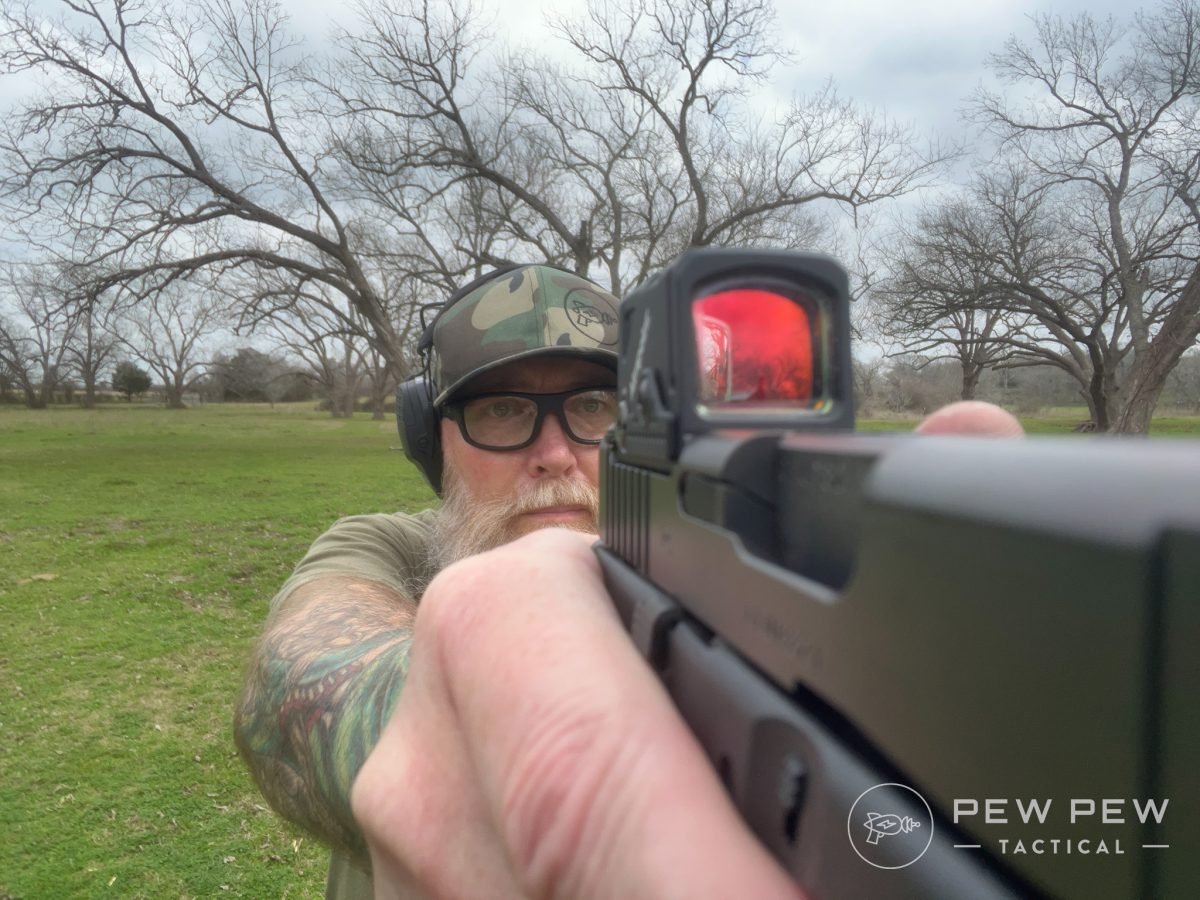
The COA came mounted on a G45 from Glock. We placed this in a Safariland SarafiVault holster and ran drills on the firing line at various distances, shooting steel targets of different sizes.
Aimpoint COA Specs & Features
Specs
- Weight: 1.7 oz.
- Battery Life: 50,000 Hours
- Illumination Settings: 12 settings (4 night vision)
- Dot Size: 3.5 MOA dot
- Objective Lens: ..59” x .59”
- Waterproof: Yes to 25 m / 82 ft
- Footprint: Glock MOS/Trijicon RMR
- Battery: CR2032
- Price: $599
Features
- A-Cut Mounting
- Modular chassis
- Side-mount battery tray
- Waterproof/Shockproof
Glock 45 Aimpoint COA Inside & Out
Internals
If you love the 3.5 MOA red dot, you’re in luck with the COA. It isn’t sold in any other configuration and has no other reticle options.
Aimpoint took an interesting approach to extending the COA’s battery life through Auto Step Down. This feature decreases the brightness by one power level every two hours if a button isn’t pressed.
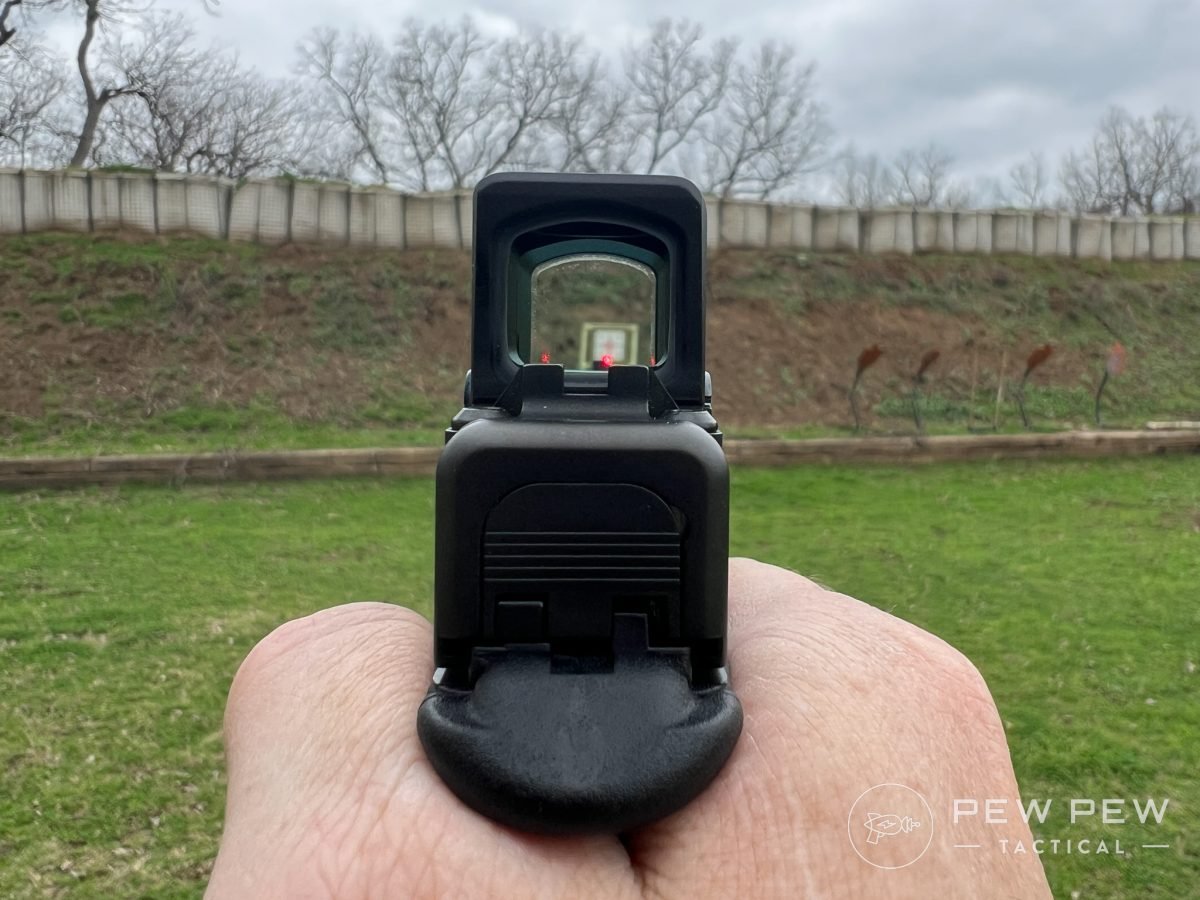
This function applies to the COA when it is set to brightness level nine or higher. There are twelve brightness settings in total.
The bottom four are designed for use with night vision, and the top setting is bright enough to still be visible in full sun. I found the dot to be crisp at lower powers, but as I increased brightness, more noise appeared.
This was most evident in the top setting, which is piercingly bright. However, it isn’t much of an issue because that power setting is really only needed in the brightest environments, and you don’t notice the noise that much.
Externals
Like other Aimpoint products, the COA is a rugged and straightforward device. The body is roughly two inches long by 1 inch high and 1 inch wide.
The COA’s frame is made of 7075-T6 aluminum, which is lightweight at only 1.7 oz. External surfaces have a semi-matte anodized finish.
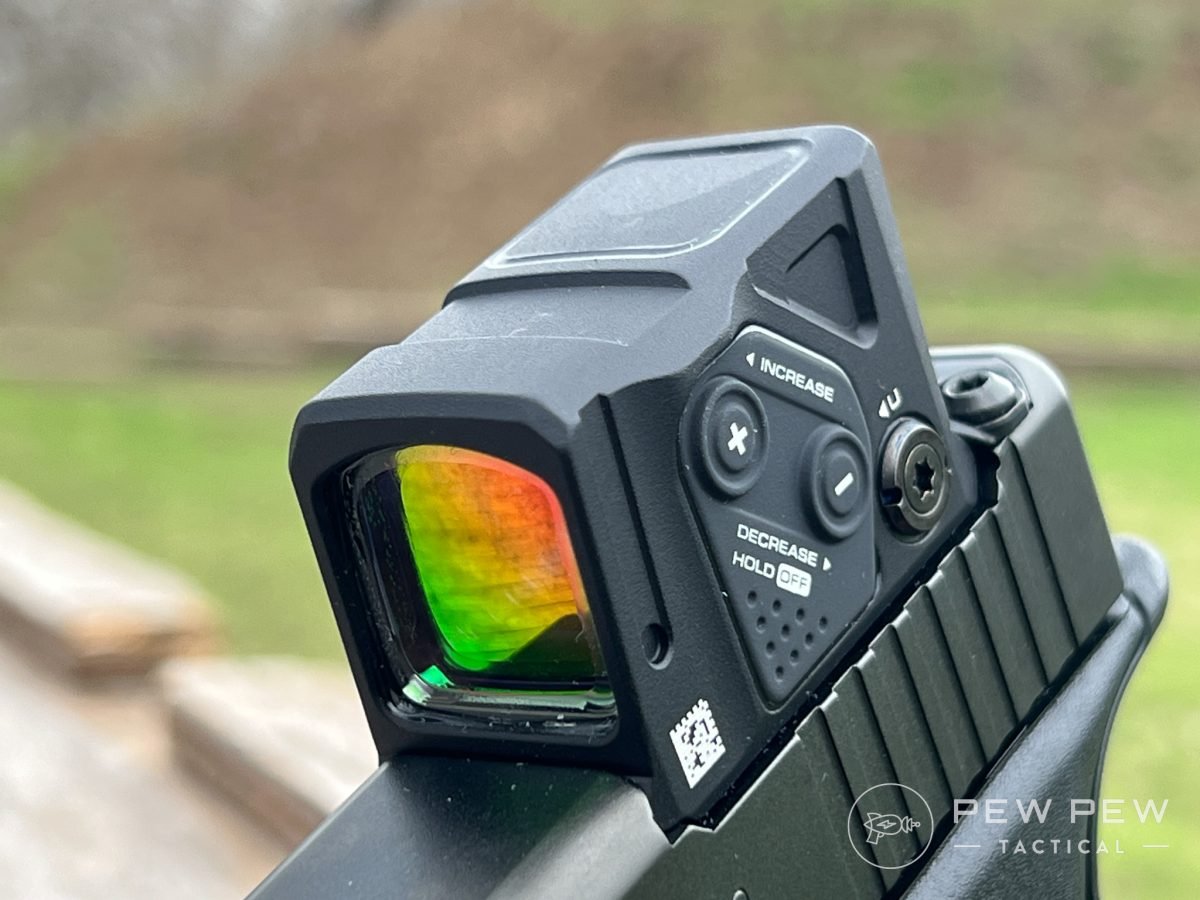
The glass is extremely clear, with a slight tint. It’s mostly square in shape, though slightly rounded at the top. The objective lens also has a coating.
On the left side, there are two buttons for operating the optic: a plus button to increase brightness and a subtract button to decrease it.
Pushing either of the buttons on the side of the COA activates the unit. Holding either button for 1.5 seconds will cause the COA to shut down completely.
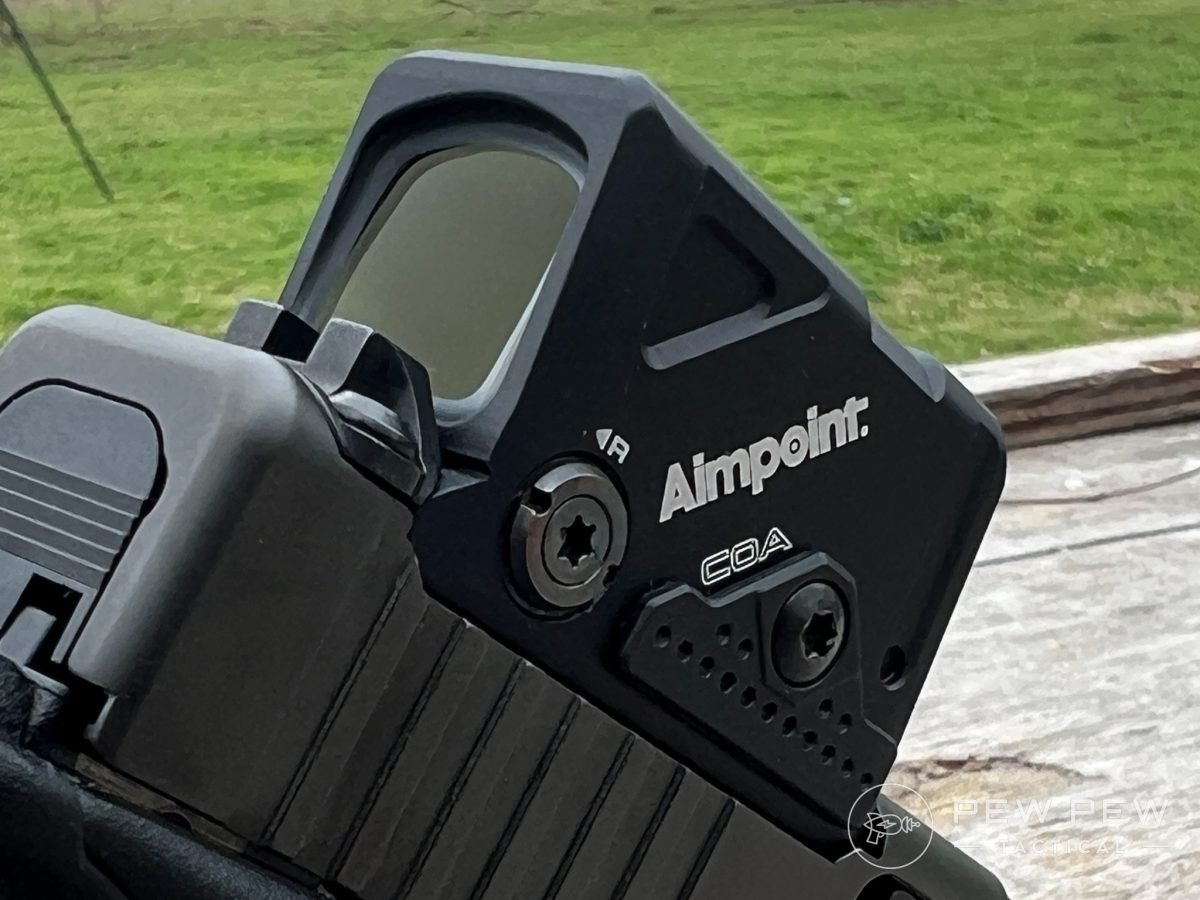
Upon startup, the COA defaults to the brightness setting eight of twelve. Users can then dial up or down from there.
The buttons are pretty small, but have a raised edge around their circumference. Pressing them lets you hear a small sound and feel a clicking sensation.
Aimpoint addressed the issue of errant button pushes by creating a safety feature. The first button push actually activates the user interface, and subsequent presses then adjust the brightness.
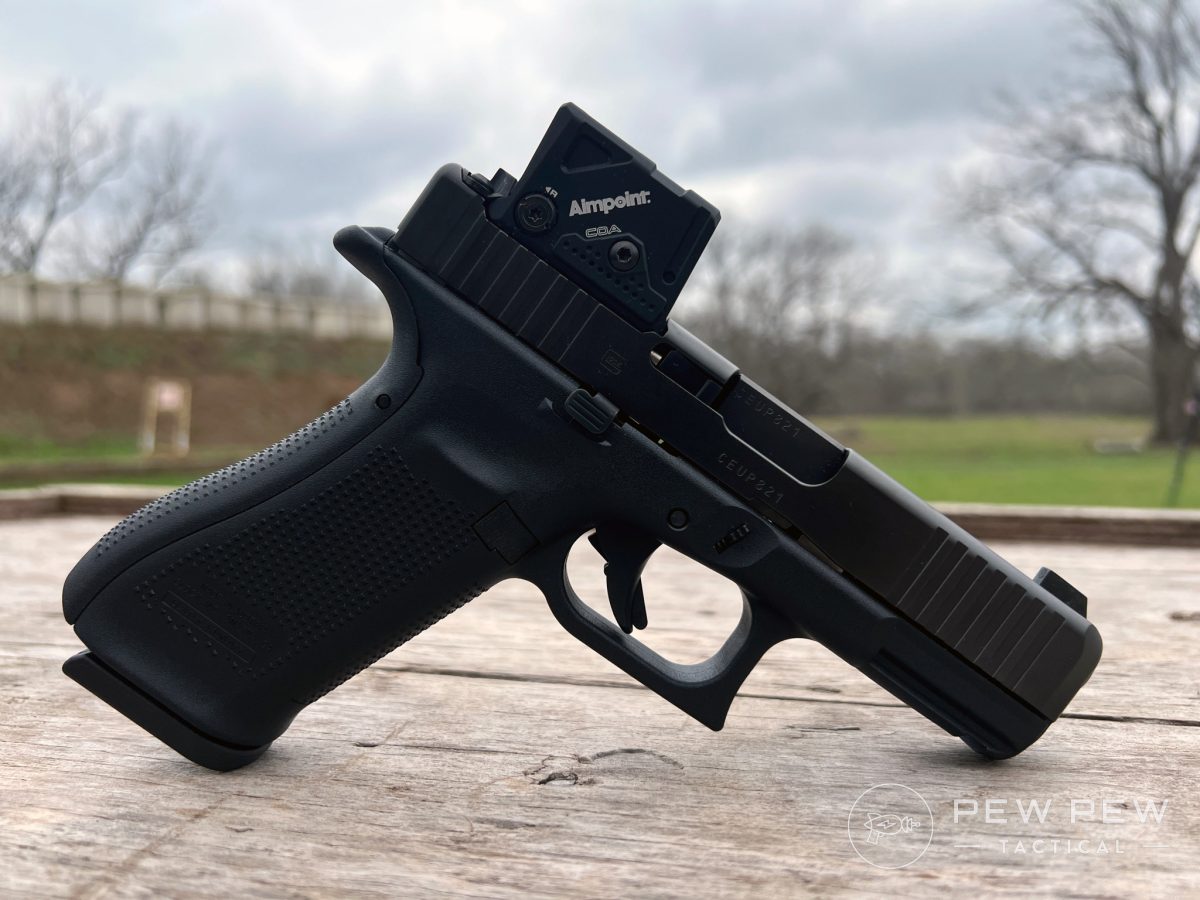
This active UI mode only lasts for four seconds, and resets with each button press. The whole idea is preventing a dot from getting bumped out of adjustment.
Imagine a scenario where it is bright outside, and your dot, which was fine in your holster, is now too dim. If the same scenario were reversed, it might also feel like looking at a miniature sun through night vision.
For the mounting system, Aimpoint has gone with a patent-pending A-Cut. This is different from the traditionally milled flat surface of a Glock MOS in that a raised channel down the middle is left.
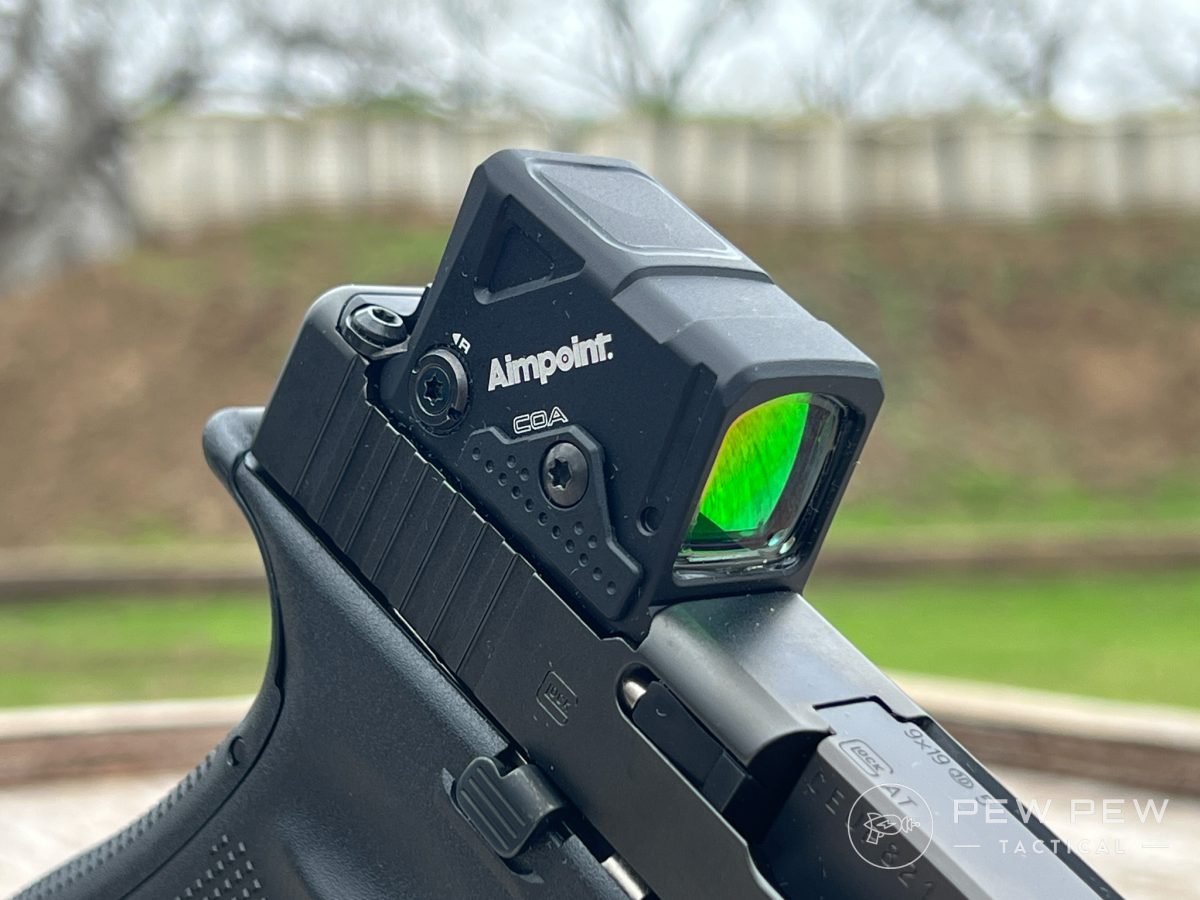
The front of the COA touches under a lip on top of the slide. The back of the unit has a sloped rear that is covered by the rear sight, which uses two Torx screws to bolt the whole thing down.
Interestingly, the result is a smaller footprint than the Aimpoint ACRO P-2 with the same viewing area. One of the benefits of this mount is the ability to still use iron sights, though more on that shortly.
The battery compartment is located on the right side of the COA and it uses a Torx screw to hold it in place. Unscrewing this allows the tray to slide out and battery change to occur without removing the optic.
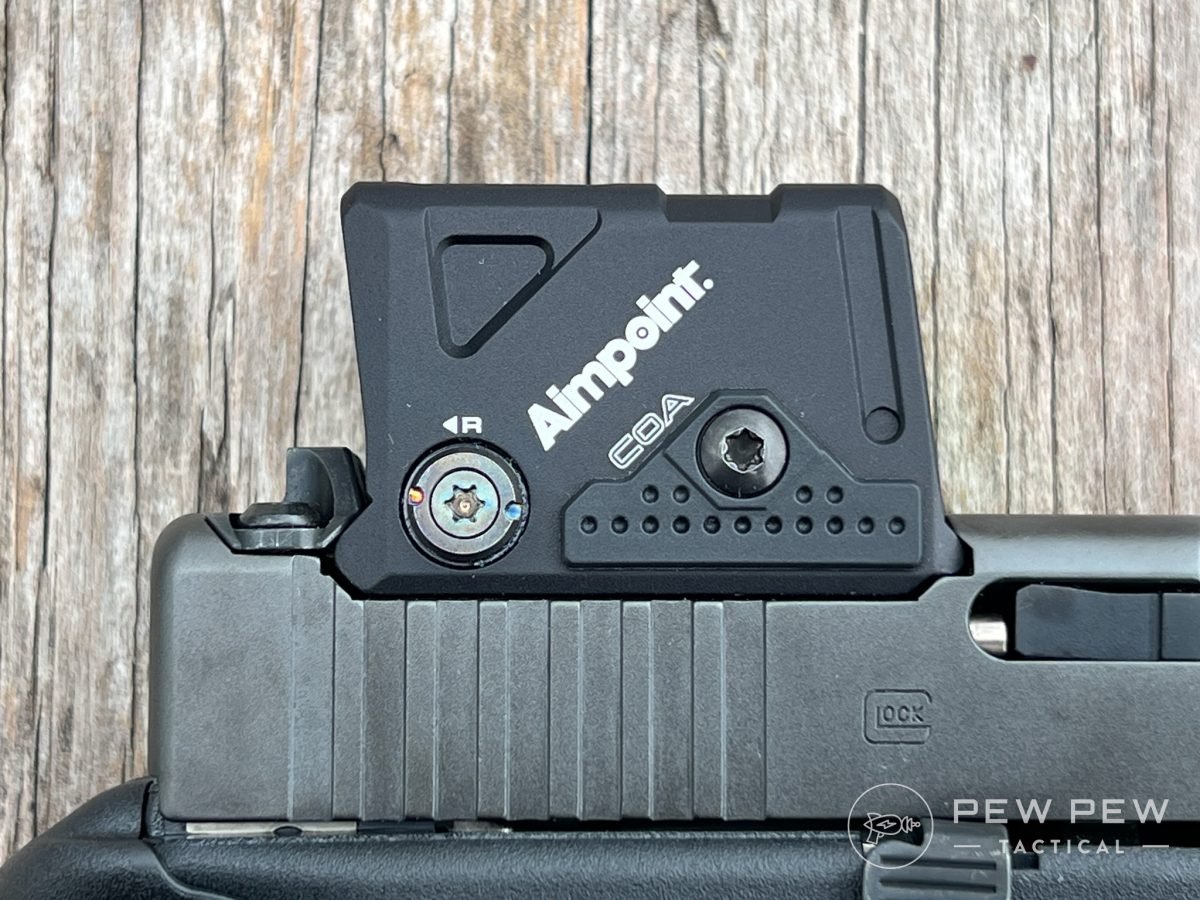
How Does the Glock 45 Aimpoint COA Shoot?
As the COA arrived on a G45 already mounted, I took it to the range and spent some time checking zero at ten yards. All the screws on the COA are Torx, including the windage and elevation.
After confirming the dot was zeroed, I tried the adjustments to see if they would track. Using a T-10, I turned the screw and was rewarded with detent clicks.
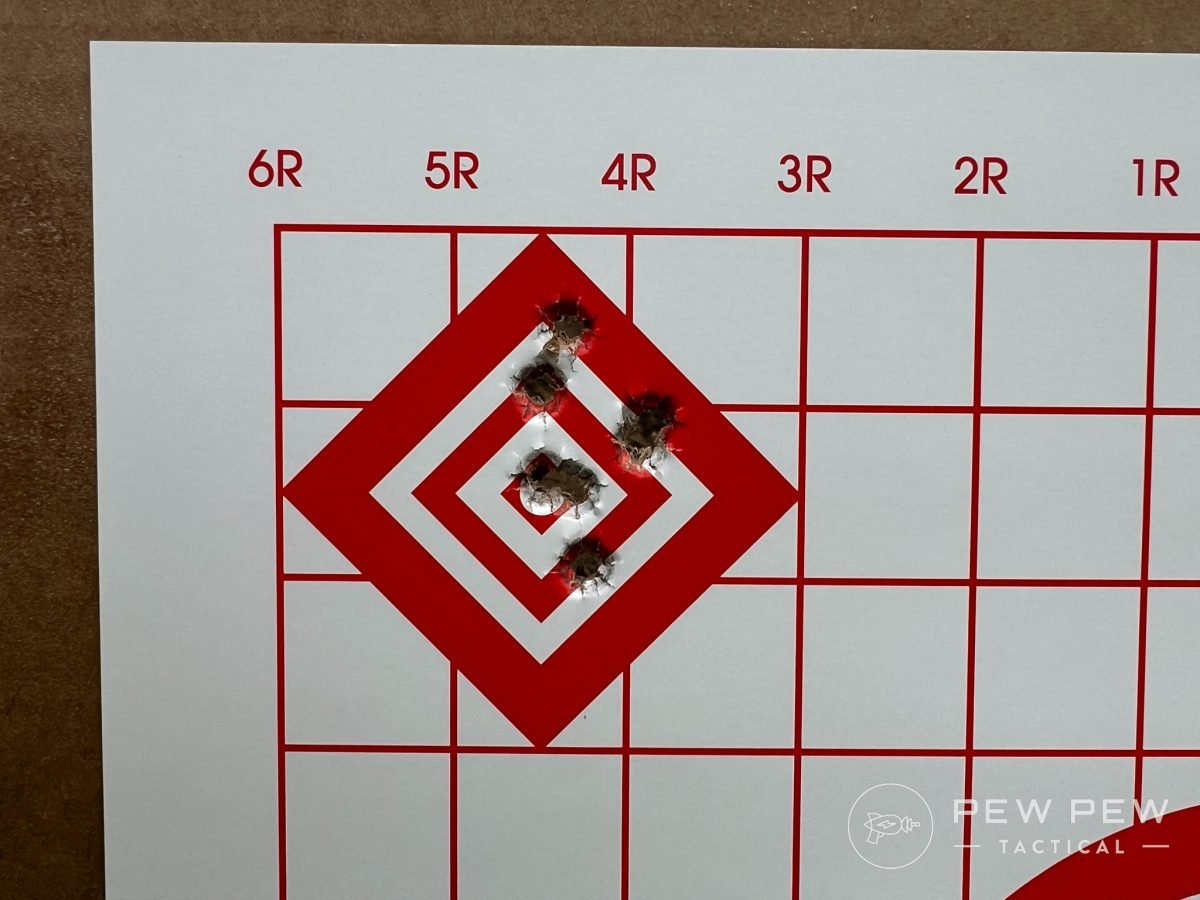
The adjustments tracked fine, and I was soon back on target. For the remainder of the testing, the dot stayed on the zero I had established.
Enclosed emitters are definitely trending in the concealed carry market right now, and the COA shows a refined approach from Aimpoint. As mentioned, the overall footprint is smaller and has the same functionality.
However, the COA feels a bit tall, but the available window is at least in the area where many people lose their dot — the vertical. With enough practice, shooters eventually present their firearm to see the dot well enough, but may lose it during recoil.

Keep in mind, too, that the unit is only about an inch tall. It’s perfectly fine for concealment and won’t gather dust bunnies or navel lint because it’s an enclosed emitter.
With a good grip, the COA’s dot darts up briefly and drops right back into the sight picture when a shot is fired. I set up a few courses of fire to test a couple of key factors.

First, I secured the G45 in a SafariVault holster and used it extensively during testing for draw and dot acquisition. The holster’s generous covering worked well and accommodated the COA’s boxy design.
With a few practice draws I worked on my presentation from the holster. The G45 broke free cleanly and I soon had repeated sight pictures with the COA.
I then began firing rounds at steel targets after presenting and increased my speed to levels where accuracy was still good. In short order, I had a good feel for the G45 and the COA.
The dot was easy to pick out, and on the overcast day I tested, I used lower settings as the highest was almost overpowering and a distraction. This sequence continued: draw, presentation, target focus with dot confirmation, then break the shot.
Finally, I transitioned to multiple targets to test the COA on lateral angles. I worked left to right, then back right to left, before eventually jumping between targets randomly.
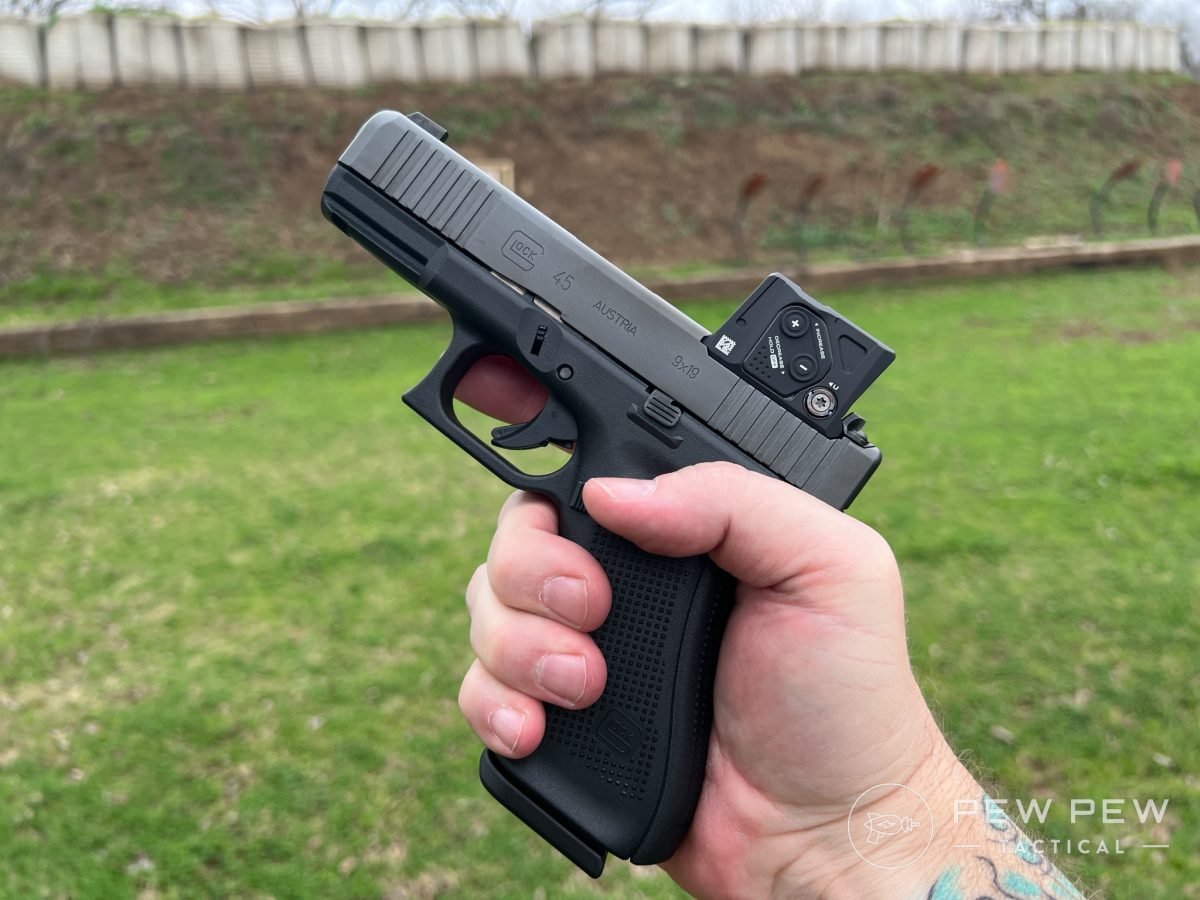
The COA was easy to track and did a great job of handling the demands of leaping from target to target. In addition, Aimpoint’s reputation for reliability held up during testing.
While I did not abuse the COA, I subjected it to normal testing and noted everything held up as expected. There was no flicker in the dot, no zero shift, and everything remained mounted.
After some time, I tested the co-witness listed as a feature in Aimpoint’s COA materials. I’ll say this…it is there, but its usability is limited.
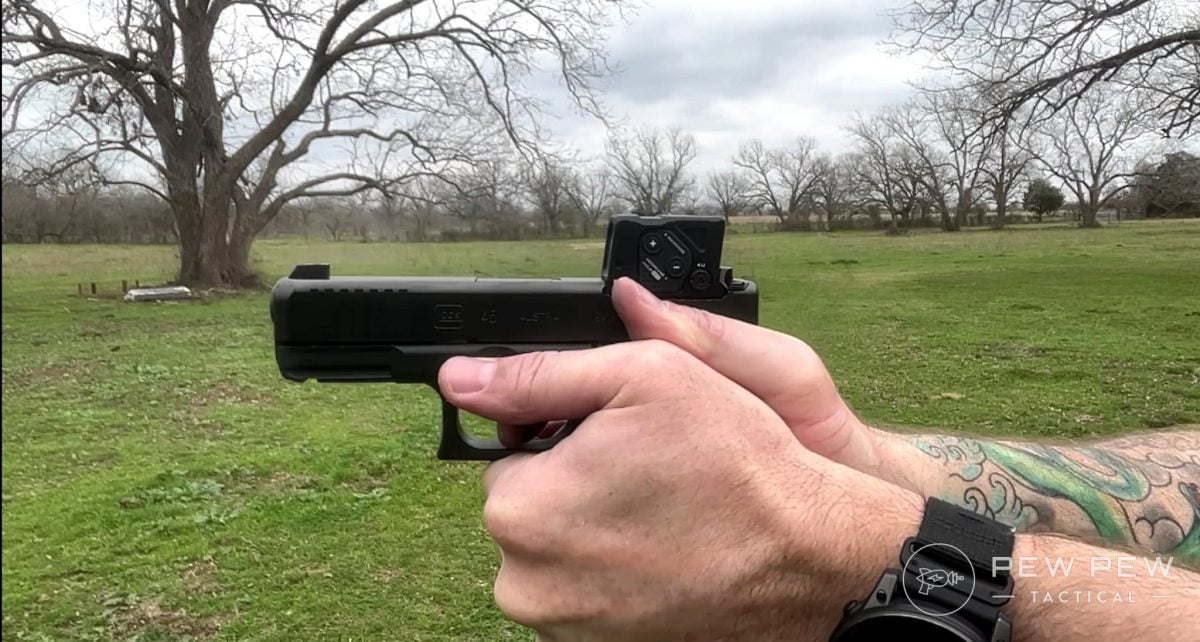
While lining up the front sight with the rear, I could see the bottom portion of the body in between the sights. This means you can only use the very top portions of the sights to align them.
Combine this with the fact that the sights on the T&E gun were blacked-out steel, and you’ve got a scenario where you could use them if you absolutely needed to, but it isn’t optimal.
Aimpoint COA View-Through
I was an early adopter of suppressor height sights on a Gen 4 Glock 17 MOS I used on duty many years ago. I appreciate redundancy and why it’s important.
If the front and rear sights were a little higher on the COA, they would be more useful.
Who Is the Glock 45 Aimpoint COA For?
I could easily see the COA being used by someone who wants one of the absolute best options for concealed carry. Based on testing and reputation, I’m confident the COA would also be worthy of professional shooters.
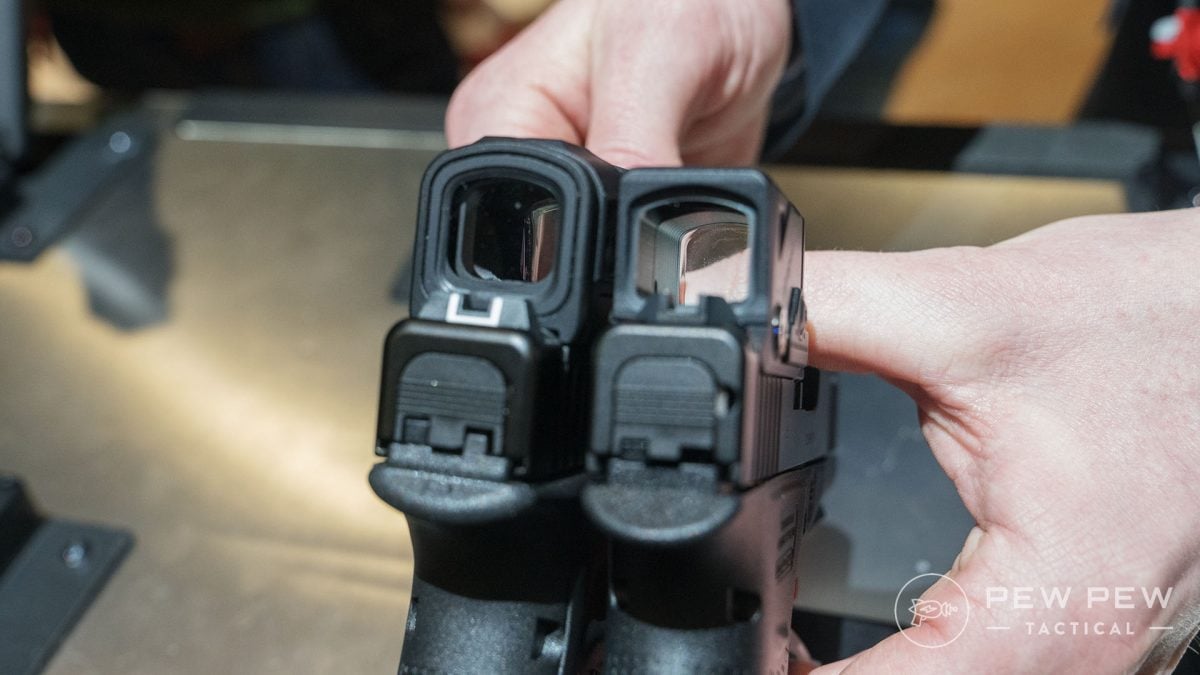
Another market the COA/Glock combo will appeal to is those who want a reliable pistol/optic pairing without having to tinker with optics plates, mounting hardware, or similar challenges.
The COA is unique because it employs a new mounting system that is innovative for only using two screws while simultaneously keeping the optic low enough for co-witness. In addition, as of this review, you are currently locked into using a Glock to enjoy the COA.

By the Numbers
Reliability: 5/5
Based on our limited test, the COA had perfect reliability. It did not loosen in its mount, lose zero, or flicker or dim during recoil.
Affordability: 2/5
You’re getting a likely bombproof red dot with an innovative mount and co-witness, but no other features. At $600, that’s a tough pill to swallow for many. I’m somewhat torn about including the currently mandatory purchase of a Glock in this category.
Looks: 3/5
The COA seems tall despite its relatively low mount, but in this case, form follows function.
Function: 4/5
The COA ran extremely well during our test and, with a potential 50,000-hour battery life, should keep working for a long time.
Overall: 3/5
Prices accurate at time of writing
Prices accurate at time of writing
-
25% off all OAKLEY products - OAKLEY25
Copied! Visit Merchant
Meet the Experts
At the helm of this review was Pew Pew Tactical Content Producer Sean Curtis. Sean has been shooting since childhood but really began to delve into guns more during his law enforcement career. He spent over two decades in law enforcement, where he became a POST-certified handgun instructor and NLEFIA Red Dot Instructor and received CLEFIA Advanced Firearms Instructor Training and AR-15 armorer training. He has since attended a variety of training, including Tactical Performance Center Handgun Mastery & Carbine Mastery, and earned USCCA rifle instructor certification. Aside from training and prior to joining the Pew Pew Tactical team full-time, Sean wrote for several gun publications evaluating and testing guns and gear and has written hundreds of articles.
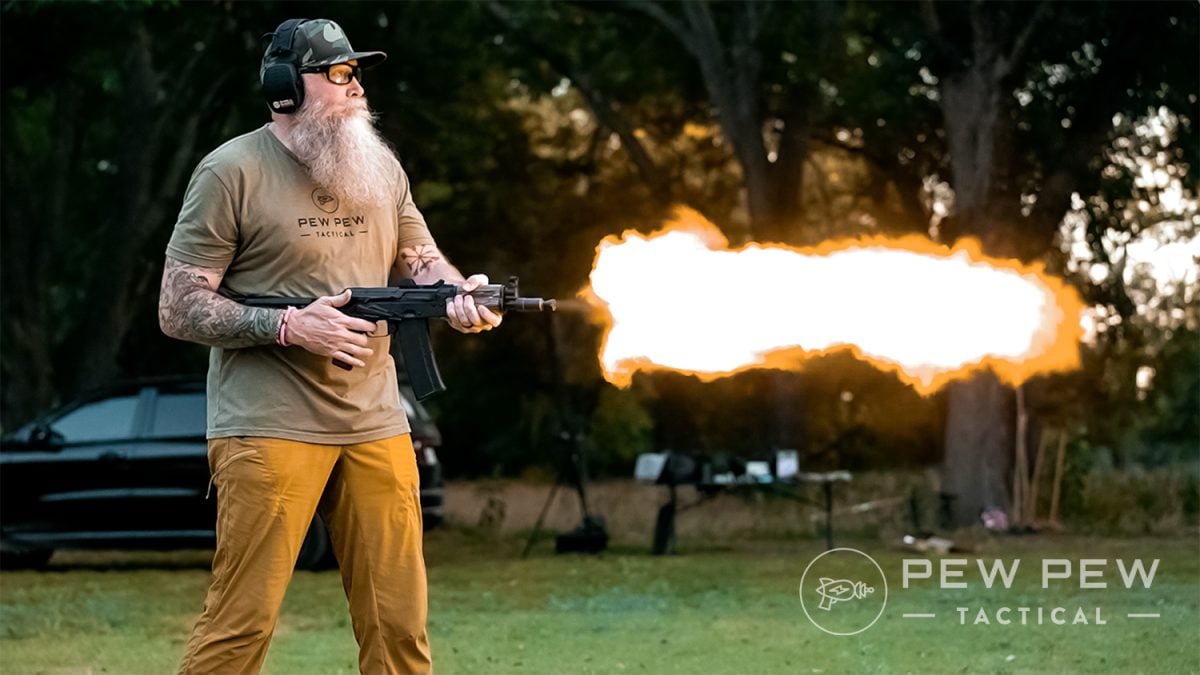
This review was edited by Editor-in-Chief Jacki Billings, who runs Pew Pew Tactical’s experienced team of reviewers. Jacki is a member of the Society of Professional Journalists, ACES: Society for Editing, and the Professional Outdoor Media Association and has her bachelor’s degree in Mass Communications. She has worked as a media professional for close to 20 years, specializing in gun media for almost 10 years, and has worked as an editor for five years. She uses her extensive professional journalism and editing experience to set testing protocols and editorial standards.
Final Verdict on the Glock 45 + Aimpoint COA
Without a doubt, Aimpoint has a reputation for simple yet rugged optics that have served for years. In many cases, that pedigree comes at a price equal to another pistol’s cost.

While that will eliminate some shoppers, those who crave the legendary toughness of an optic that’s always on for five years have a solid choice in the COA—but don’t forget to save some money for the Glock too!
Will you pony up for a Glock and Aimpoint COA? Let us know in the comments below! Check out Best Pistol Red Dot Sights [Real-Views + Video] for even more options!

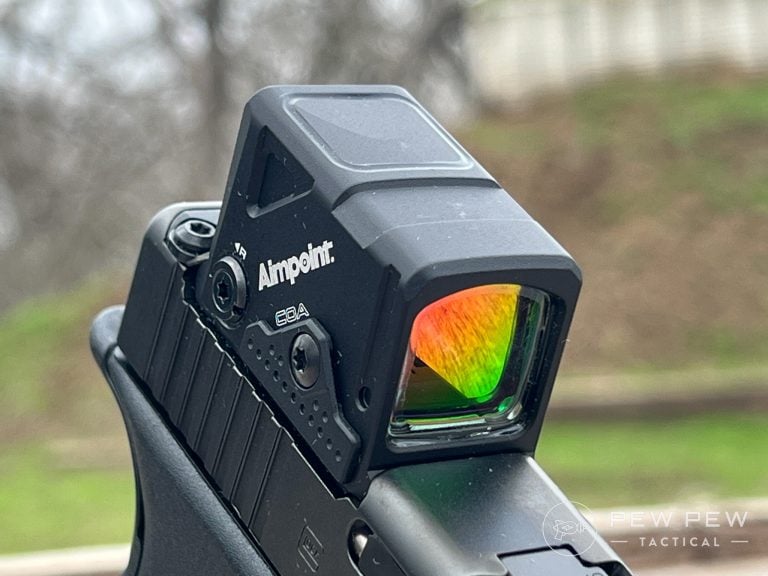
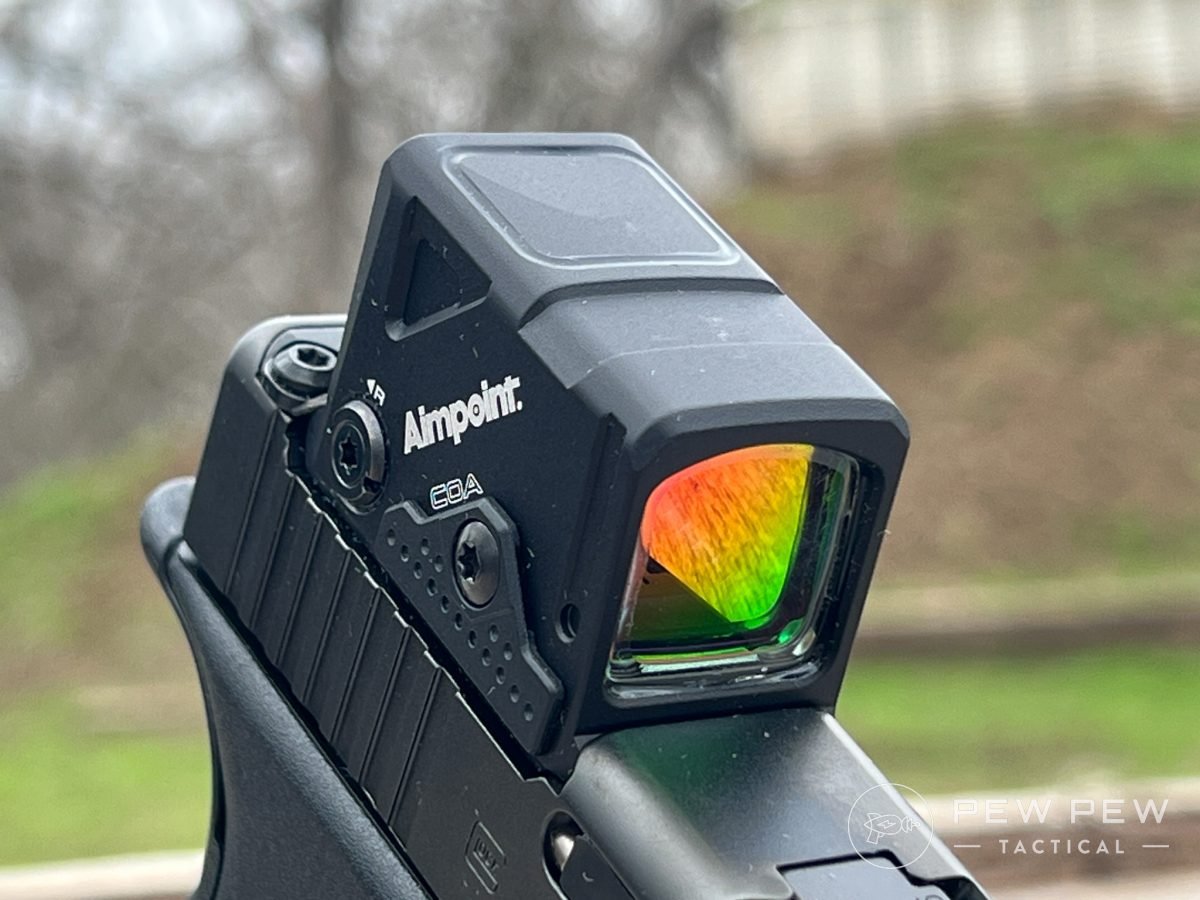

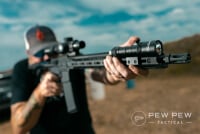





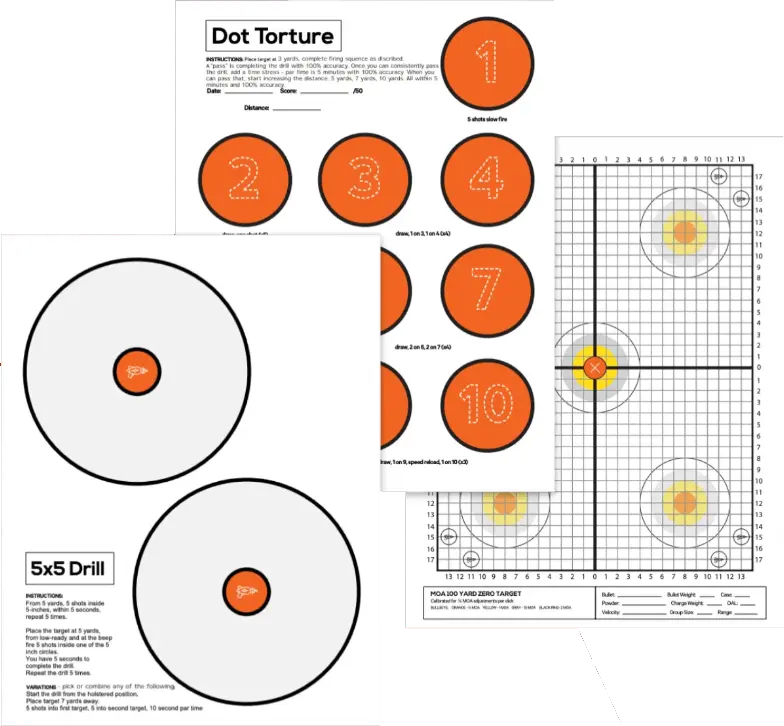
3 Leave a Reply
I find it funny about the affordability and Glock and even say RMR will run you more than this. To get a Glock and COA for 900 thats a steal 750 for 43/48. i think thats a 5/5 for affordability. tell me a better combo cheaper?
Been a Glock guy since they came to be, Carried one on duty for 20 years. Never let me down. Own several Glocks. I recently purchased a Glock 43x COA and love that gun. Well worth the money if you like Glocks.
Have never been a "Glock" guy and hadn't fired one until this past March at a "Range Day" in Central Florida. Glock had a booth there with many different pistols to try and one of them was a Glock 47 with the Aimpoint sight. (Aimpoint had a booth right next to the Glock booth). I explained to the rep that I had never shot a Glock and that my go-to pistols were a CZ-P01 and a Sig P226 MK25. Had me try a Glock 19, meh, no big deal. then handed me the Glock 47 with the Aimpoint on it and I tried that. I ended up going back three more times to shoot it. Honestly, if I was going to purchase a Glock, this would be the combination I would go for. I also do not shoot with a red dot, neither of the two pistols I mentioned have optics. As a vet the Blue Label program makes this a bit more affordable but besides the cost, I felt that this combination might be a good option to add to my personal collection. Was pleasantly surprised.